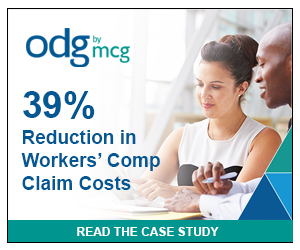Industry Insights
July 9, 2018
Frederick: Workplace Wearables: New Use of Big Data
- National
- - 0 shares
Wearables continue to be the hottest topic in smart technology because of gadgets like Fitbits, Apple Watches and Nike Fuelbands. But what about a wearable that uses big data to revolutionize workplace safety?

Mark Frederick
In a world where almost 1,000 workers don’t come home each day due to workplace injury, understanding how workplace incidents happen and taking steps to prevent future injuries should be a company’s top priority.
Insurers want to provide the most efficient workers’ compensations and property/casualty policies, and now they can from the data and machine learning of wearables.
Wearables are providing efficiencies in gathering data that can then be processed to provide insights for workplace injury trends. Automated collection of individualized worker safety data at scale is far more efficient than the traditional observation techniques used by safety experts to collect risk data.
Wearables don’t require employees to log information or have their cellphone constantly handy, and they offer a seamless information transfer between users, especially important in industries with high employee turnover rates.
At MakuSafe, we’re developing a wearable solution that collects and tracks environmental data, which is processed through MakuSmart, our cloud-based machine learning platform, to help manufacturing facilities build a culture of safety.
So, we understand that wearables are essential for the safety management of an organization. But wearables can provide data just as valuable to insurance carriers.
Manufacturing companies and warehouses across the world are losing time and money on avoidable safety hazards and compensation. Data from workplace wearables creates remediation steps to help streamline reducing worksite risk, and allow carriers to generate tailored advice for policies and more efficiently justify premiums.
Internet of things capabilities fill this picture in even further, with the ability to alert safety managers to potential risks or even take automated steps to help mitigate risks based on identified trends.
With insurance companies often only having limited visibility into the risks policy holders’ workers are experiencing, IoT devices give risk reduction professionals the eyes and ears they need to understand what environmental conditions could be contributing to hazards. That means quicker intervention when data shows leading indicators of risk are present, instead of waiting for an injury or claim.
Armed with this more complete picture of workplace risk, thanks to more accurate and precise trend data, insurance carriers can target, select and price risk more specifically for policyholders, and accelerate time to value on policies. The individualized view of risk permits safety and risk mitigation experts to precisely prescribe remediation steps that are specific to worker risks and better measure the remediation efficacy.
None of this data is biometric — rather, workplace wearables track the environment around an employee, not from the employee. It is intended to generate a 360-degree view of a worker’s risk exposure. Through data analytics and machine learning, wearables can transform from an informative personal health-monitoring device to an essential workplace data tool, without invading employee privacy.
The predictive value of individualized workplace safety data can clearly expose risks before they turn into an injury. With this in mind, insurance companies should be looking for companies to provide solutions for their manufacturing clients, while warehouses and manufacturing companies should be jumping at the chance to test these money/time/life-saving devices.
By building a strong partnership among data-driven intelligence, workers and the resources that can be deployed by insurance companies and other safety providers, workplace risks can be reduced and, ultimately, more workers will make it home safely to their friends and families each day.
Mark Frederick is co-founder and chief technology officer of MakuSafe Corp. This blog post is reprinted by permission from InsuranceThoughtLeadership.com.
Advertisements
Columns
- Moore: Reciprocity Adds Authority 04/23/24
- Montgomery: Sedgwick Tries PPO Discount for Med-Legal (Again) 04/19/24
- Kamin: More Policy Exclusions Would Reduce Losses 04/18/24
- Phillips: It's All Settled 04/17/24
- Snyder: Public Benefit Rules Have Changed, but It Might Not Make a Difference 04/12/24
- Headrick: Clearing Up a Common Misconception 04/11/24
- Snyder: Litigation Guidelines Should Define Four Settlement Triggers 04/10/24
- Kirsch: Depositions of Comp Carrier Employees After Intervening in Third-Party Actions 04/09/24
- Wilson and Bennett: Could AI Have Prevented the Opioid Crisis in Workers' Comp? 04/08/24
- Moore: Pandemic Effect Over in March 2027. Really? 04/05/24
- Geaney: A Brief History of Our State's Workers' Compensation Act 04/04/24
- Kamin and Larres: Significant Panel Decision Clarifies Recon Confusion 04/03/24
- Gelman: Exposed to 'Forever Chemicals' 04/02/24
- Montgomery: Cyberattack Delays Payment of San Francisco Bills 04/01/24
- Young: Indoor Heat Regs in Turmoil 03/29/24
- Langham: Shootings and Compensability 03/27/24
- Geaney: Third-Party Liens Not Always Due Right Away 03/26/24
- Larres: State Supreme Court Denies Review of Our Appellate Win 03/25/24
- Moore: Recordkeeping and Your Remote Premium Auditor 03/22/24
- Switzer: Important Change Coming Soon 03/21/24
Now Trending
- Workers' Compensation News
-
Calif.
Chiropractor Sentenced to More Than
54 Years, Fined…
Posted on Apr 16, 2024
-
Calif. Court
Upholds Summary Dismissal of
Worker's Claims for Retaliation,…
Posted on Apr 17, 2024
-
Calif. WCIRB
Approves Recommendation for 0.9%
Rate…
Posted on Apr 18, 2024
-
Calif. Committee
Passes Bill to Expand 4850…
Posted on Apr 22, 2024
-
Calif. Committee
Passes Bill to Revise Poster…
Posted on Apr 19, 2024
-
Calif. Cal/OSHA
Cites Construction Company $371,100
for Fatal Trench…
Posted on Apr 22, 2024
-
Calif.
Appropriations Committee Schedules
Hearing on E-Signature…
Posted on Apr 22, 2024
-
Minn. Supreme
Court Upholds Award to Social
Worker for…
Posted on Apr 19, 2024
-
N.Y. Carrier Has
No Duty to Defend Insured From
Labor Law…
Posted on Apr 22, 2024
-
Ark. Worker Not
Entitled to Additional Benefits
After Date of…
Posted on Apr 22, 2024
Jobs
Upcoming Events
May 5-8, 2024
Risk World
Amplify Your Impact There’s no limit to what you can achieve when you join the global risk managem …
May 13-15, 2024
NCCI's Annual Insights Symposi
Join us May 13–15, 2024, for NCCI's Annual Insights Symposium (AIS) 2024, the industry’s premier e …
May 13-14, 2024
CSIA Announces the 2024 Annual
The Board of Managers is excited to announce that the CSIA 2024 Annual Meeting and Educational Con …
Social Media Links
c/o Business Insurance Holdings, Inc.
Greenwich, CT 06836





No Comments
Log in to post a comment